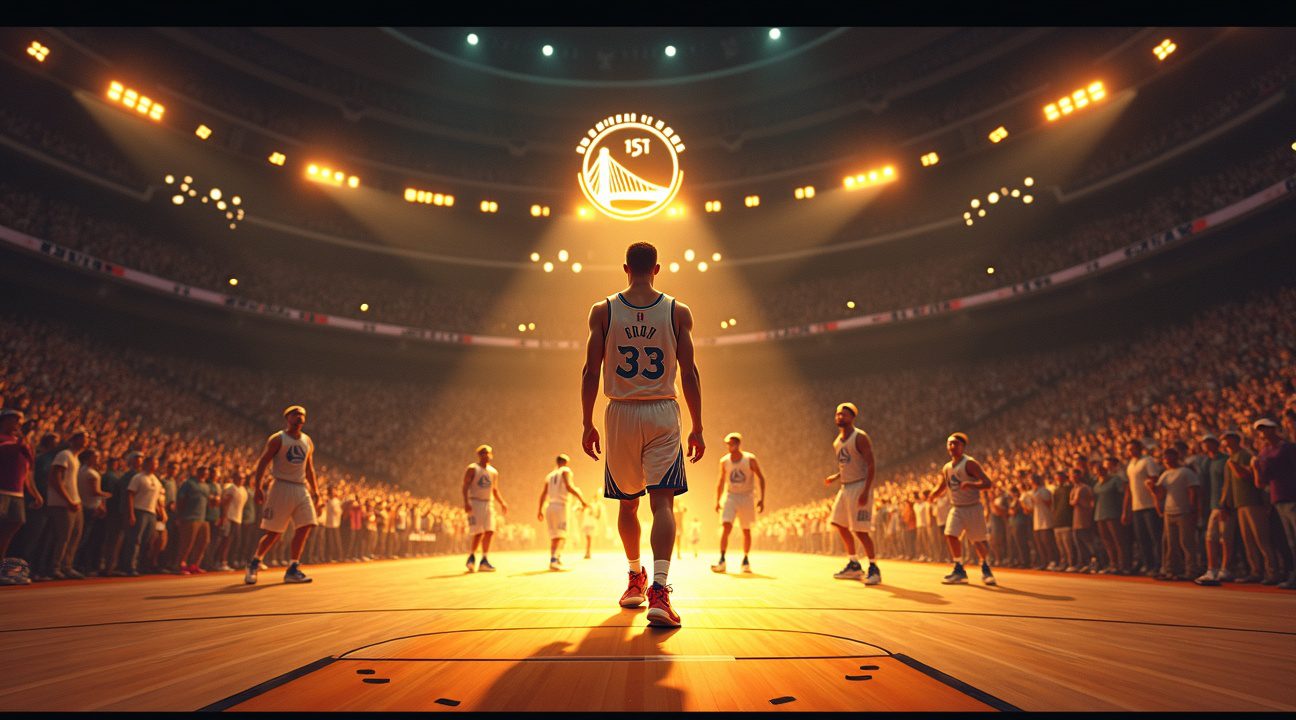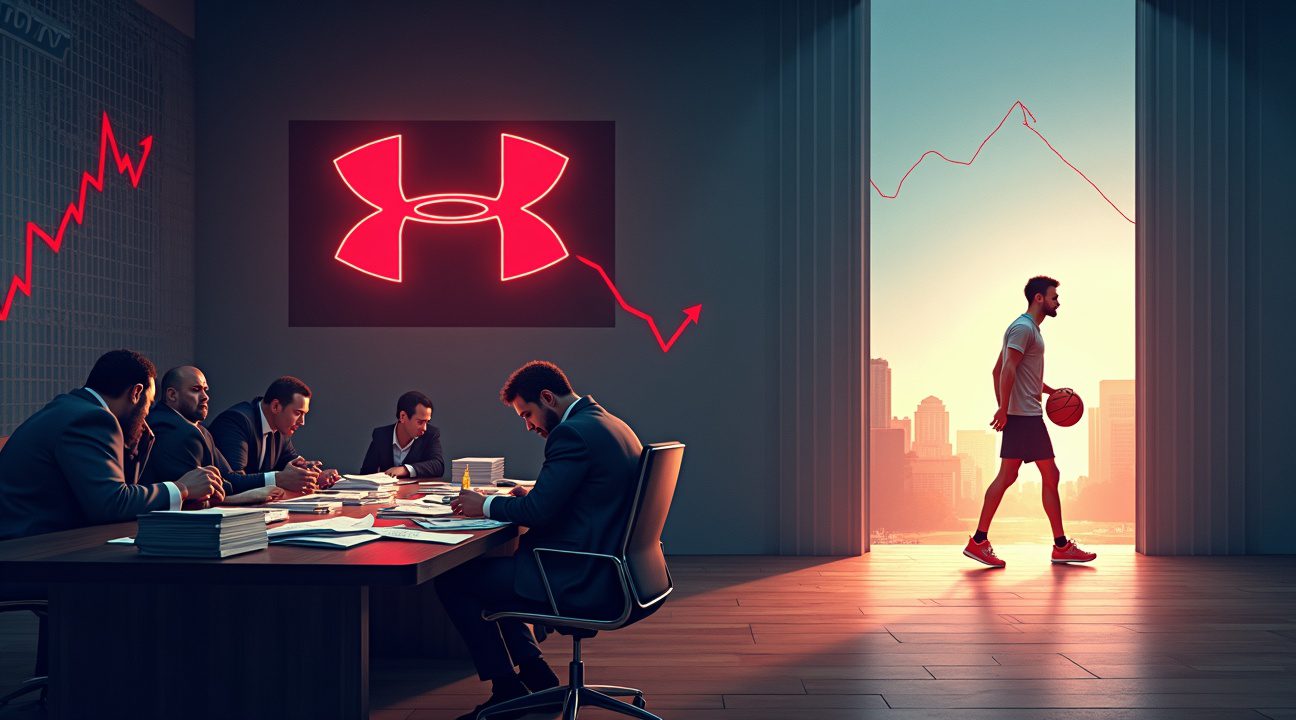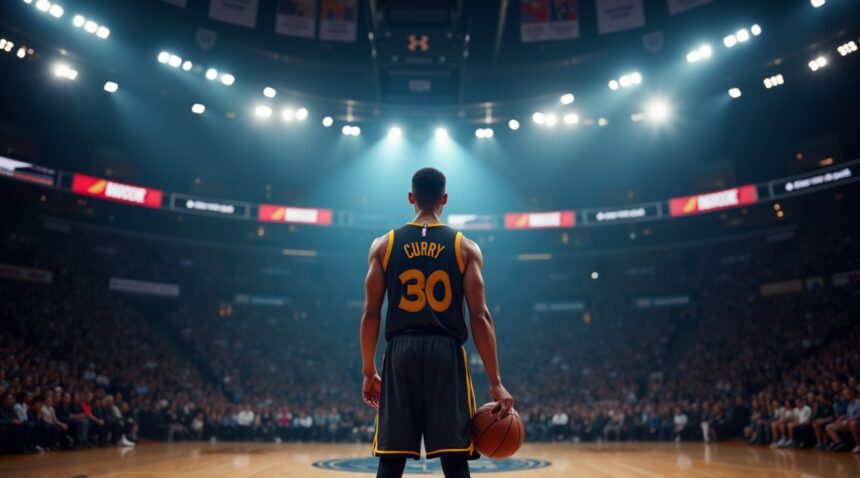Stephen Curry and Under Armour officially terminated their 12-year partnership in November 2025, creating a major shift in sports marketing as the Golden State Warriors superstar achieves complete independence from the sportswear company.
This separation demonstrates Under Armour’s strategic decision to restructure during a time of financial instability, while positioning Stephen Curry to take full control of his brand and its future direction.
Key Takeaways
- Curry now owns and operates Curry Brand independently, gaining full creative and business autonomy without corporate influence.
- Under Armour’s exit is a response to significant financial challenges, including a 76% stock decline during their partnership despite Curry Brand generating $100–$120 million annually.
- Curry Brand has secured the right of first refusal for former Under Armour athletes, offering a competitive edge in attracting sports talent.
- This move enables Curry to pursue new partnerships across industries such as golf, tech, and entertainment without being tied to restrictive contracts.
- Under Armour is redirecting its focus toward its core competencies: athletic wear and equipment innovation as it executes a broader restructuring strategy.
For more insights about Curry’s expanding business ventures, visit the official Curry Brand website.
Golden State Warriors Star Breaks Free from Under Armour After 12 Years
Stephen Curry and Under Armour have officially ended their 12-year partnership in November 2025, closing the chapter on one of basketball’s most influential athlete-brand relationships. This separation marks a pivotal moment in sports marketing history, as the Golden State Warriors superstar gained his freedom from the sportswear giant that helped elevate both his personal brand and the company’s basketball division.
Under Armour announced the separation as part of a strategic shift to focus more closely on its core brand offerings. The company has decided to streamline its athlete portfolio while concentrating on products that align with its fundamental business objectives. This decision reflects Under Armour’s evolving priorities as it adapts to changing market conditions and consumer preferences.
Independent Path Forward for Curry Brand
Curry Brand will now operate independently, creating exciting possibilities for future partnerships and collaborations. The brand has established a strong foundation during its time under the Under Armour umbrella, building recognition and credibility that will serve it well in this new chapter. Industry experts anticipate that Curry Brand will explore various partnership opportunities, potentially with major athletic companies or through innovative direct-to-consumer approaches.
This independence gives Curry unprecedented flexibility in his endorsement strategy. He can now wear different brands during games and public appearances, opening doors for partnerships across multiple categories. Similar high-profile athlete partnerships have shown how strategic brand relationships can evolve to benefit both parties while maintaining individual identity.
The split represents significant developments in athletic sponsorships, particularly for established superstars who have built substantial personal brands. Curry’s situation parallels other elite athletes who have transitioned from traditional endorsement deals to more entrepreneurial ventures. Basketball legends like LeBron James have demonstrated how athletes can leverage their success into broader business opportunities beyond single-brand partnerships.
Market analysts suggest that Curry’s newfound freedom could lead to innovative collaboration models that haven’t been explored in traditional athlete endorsements. His proven track record of driving sales and brand awareness makes him an attractive partner for companies seeking authentic connections with basketball fans and broader consumer markets.
The timing of this separation coincides with Curry’s continued excellence on the court, as he remains one of the NBA’s most marketable stars. His success with the Warriors organization under coach Steve Kerr has maintained his relevance and appeal to sponsors across various industries.
Under Armour’s decision to part ways with Curry reflects broader trends in the athletic apparel industry, where companies are reassessing their investment strategies in athlete partnerships. The company must now navigate the basketball market without one of its most recognizable faces, while Curry gains the opportunity to explore relationships that might offer greater creative control and financial flexibility.
This development also highlights the changing dynamics between athletes and corporate sponsors, where traditional long-term exclusive deals are giving way to more fluid arrangements. Basketball icons like Kobe Bryant paved the way for athletes to think beyond traditional endorsement structures, creating pathways for more entrepreneurial approaches to brand building.
The separation allows both parties to pursue strategies that better align with their current objectives. Under Armour can focus resources on athletes and products that fit their refined brand vision, while Curry can explore partnerships that maximize his influence across multiple platforms and industries.
Industry observers will closely watch how both Under Armour and Curry navigate their respective paths forward. The success of this transition could influence how other high-profile athlete-brand relationships evolve in the future, potentially setting new standards for partnership flexibility and independence in professional sports marketing.
How a 2013 Deal Transformed Under Armour’s Basketball Presence
Stephen Curry’s decision to sign with Under Armour in October 2013 fundamentally altered the athletic brand’s standing in basketball. At the time, Under Armour held minimal presence in the basketball market, overshadowed by giants like Nike and Adidas. Curry’s partnership changed that dynamic completely, transforming Under Armour from a performance apparel company into a legitimate basketball powerhouse.
The collaboration began when Stephen Curry chose Under Armour over more established competitors, despite their smaller basketball footprint. This calculated risk paid off dramatically as Curry’s on-court success directly translated into brand visibility. His MVP seasons and championship runs provided Under Armour with unprecedented exposure in prime-time basketball moments.
Signature Success and Brand Evolution
Under Armour’s basketball transformation accelerated through several key developments during their partnership. The launch of Curry’s signature shoe line became an instant success story, with multiple iterations capturing both performance innovation and street credibility. Each new release built upon previous success, establishing Under Armour as a serious competitor in basketball footwear.
The evolution reached its peak with the creation of the Curry Brand, a dedicated subsidiary that operated with increased autonomy within Under Armour’s structure. This move demonstrated the company’s commitment to basketball and recognized Curry’s unique position as both athlete and brand ambassador. The Curry Brand allowed for more focused product development and targeted marketing strategies.
Under Armour’s market position improved significantly during the early years of this collaboration. The company’s basketball revenue grew exponentially, driven by Curry’s popularity and on-court achievements. Brand perception shifted from purely functional athletic wear to lifestyle-oriented basketball culture, attracting younger demographics previously unreachable.
The partnership’s impact extended beyond Curry himself, as Under Armour began attracting other high-profile basketball athletes. The brand’s enhanced credibility in basketball circles made it a more attractive option for emerging talent and established players seeking alternatives to traditional powerhouses.
The Curry-Under Armour connection ultimately became one of modern basketball’s most impactful athlete-brand partnerships. Similar to how other transformative deals reshaped their respective sports, this collaboration redefined what smaller athletic brands could achieve with the right athlete partnership. The success proved that strategic alignment between brand values and athlete persona could overcome market disadvantages and create lasting competitive advantages.

Under Armour’s Financial Struggles Paint Clear Picture Behind Split
Under Armour’s decision to part ways with Stephen Curry reflects deeper financial challenges that have plagued the company since their partnership began in 2013. The athletic apparel giant has watched its stock price plummet by approximately 76% during this period, signaling fundamental issues with the company’s broader strategy and market position.
Basketball Division Success Couldn’t Overcome Broader Struggles
Despite the Curry Brand generating an estimated $100 million to $120 million in annual revenue for Under Armour’s basketball division, these impressive figures couldn’t mask the company’s persistent struggles with overall revenue growth and brand perception. The basketball segment performed well, but Under Armour faced mounting pressure across other product categories and market segments. Revenue stagnation in key areas forced executives to make difficult decisions about resource allocation and partnership investments.
The financial pressures became increasingly difficult to justify, especially when considering the substantial investment required to maintain a partnership with one of basketball’s biggest stars. NBA partnerships demand significant marketing budgets and guaranteed payments that can strain companies experiencing financial difficulties.
Strategic Implications for Both Parties
This separation creates distinct advantages for both Under Armour and Curry moving forward. Under Armour can now redirect the substantial financial resources previously committed to the Curry partnership into other growth initiatives or cost-cutting measures. The company gains flexibility to pursue different marketing strategies and potentially more cost-effective endorsement deals that better align with their current financial position.
For Curry, the split represents an opportunity to gain greater control over his brand and potentially increase its valuation significantly. Independent athlete brands often command higher valuations when they’re not tied to struggling corporate partners. Successful athlete partnerships in other sports have shown that timing these transitions correctly can be crucial for long-term brand value.
The financial reality facing Under Armour made this partnership increasingly unsustainable despite the success of the Curry Brand itself. The company’s stock performance and broader market challenges created a situation where even profitable partnerships became difficult to justify from a strategic standpoint. This decision reflects Under Armour’s need to streamline operations and focus resources on areas with the highest potential return on investment during these challenging financial times.

Curry Brand’s Independent Future and Control Over Athlete Roster
The separation from Under Armour marks a pivotal transformation for Stephen Curry as he assumes complete ownership and operational control of Curry Brand. This transition positions the basketball superstar as both the face and business leader of his own athletic empire, eliminating the corporate layers that previously influenced brand decisions.
Strategic Control Over Talent Acquisition
Curry Brand’s most significant advantage lies in securing the right of first refusal for athletes who held contracts with Under Armour. This contractual provision grants the brand priority access to negotiate with departing Under Armour athletes before they can sign with competing companies. Such positioning creates a substantial competitive edge in the endorsement landscape, allowing Curry to handpick talent that aligns with his brand vision and values.
The right of first refusal operates differently from traditional recruiting methods used by established brands like Nike, which have historically dominated athlete partnerships through massive financial commitments. Instead of competing purely on contract size, Curry Brand can leverage personal relationships, brand authenticity, and shared athletic philosophy to attract top performers. This approach mirrors successful independent ventures in other sports, where athlete-owned brands have gained traction through more personalized partnerships.
Athletes considering their options will likely find appeal in joining a brand led by someone who understands the pressures and demands of professional sports firsthand. Curry’s experience competing at the highest levels provides credibility that corporate executives simply cannot match, potentially attracting talent who value mentorship alongside financial compensation.
Expanded Strategic Opportunities
Direct ownership eliminates the bureaucratic constraints that often slow decision-making in large corporations. Curry can now pivot quickly on partnership opportunities, product development, and marketing campaigns without seeking approval from Under Armour’s board or navigating corporate politics. This agility becomes particularly valuable in today’s fast-moving sports marketing environment, where timing often determines success.
The brand’s future extends beyond basketball endorsements into diverse athletic categories. Curry’s proven track record and business acumen position him to explore partnerships across golf, tennis, soccer, and emerging sports where authentic athlete leadership resonates with consumers. Unlike corporate brands that must balance multiple stakeholder interests, Curry Brand can focus exclusively on building genuine connections with athletes and fans.
Cross-sport collaborations present exciting possibilities for the independent brand. Tiger Woods and Nike’s partnership demonstrated how athlete-brand alliances can transcend individual sports to create cultural phenomena. Similarly, LeBron James’s various business ventures show how basketball stars can leverage their platform across multiple industries.
The independence also allows for more creative and risk-taking approaches to athlete development. Rather than following traditional endorsement models, Curry Brand can experiment with:
- Revenue-sharing arrangements
- Equity partnerships
- Performance-based incentives
These innovative structures could attract ambitious athletes seeking more than standard endorsement deals.
Product development decisions now rest entirely with Curry’s vision rather than corporate committees focused on broad market appeal. This control enables the brand to create specialized equipment and apparel that reflects authentic athlete needs rather than mass-market assumptions. The result could be products that genuinely enhance performance while building stronger emotional connections with users.
Financial flexibility represents another crucial advantage of independence. Without corporate oversight requiring specific profit margins or quarterly targets, Curry Brand can invest strategically in long-term relationships and brand building. This freedom allows for patient development of athlete partnerships and market positioning that might not generate immediate returns but create lasting value.
The transition positions Curry Brand to compete directly with established athletic giants while maintaining the personal touch that resonates with modern consumers. Athletes increasingly seek partnerships that extend beyond simple endorsement payments, looking for brands that support their personal growth, social initiatives, and long-term career development. Curry’s hands-on leadership style and authentic connection to athletic excellence create natural appeal for such partnerships.
What’s Next for Curry’s Brand Empire Beyond Basketball
Stephen Curry’s entrepreneurial vision extends far beyond the hardwood, and his newfound independence positions him to capitalize on opportunities that basketball alone couldn’t provide. With his diverse interests spanning music and entertainment, Curry’s brand evolution represents a strategic shift toward building a comprehensive lifestyle empire.
Expanding Into New Athletic Markets
Golf emerges as the most natural extension for Curry’s athletic brand presence. His well-documented passion for the sport, combined with his celebrity status, creates a perfect storm for market penetration in an industry that thrives on prestige and performance. Unlike other athletic endorsement deals that often restrict cross-sport ventures, Curry’s independence allows him to pursue golf equipment partnerships, apparel collaborations, and course design opportunities without contractual barriers.
The golf market offers several compelling advantages for brand expansion:
- Premium pricing structures that generate higher margins than basketball products
- Year-round engagement opportunities through tournaments and events
- Access to affluent demographics that align with luxury brand positioning
- International market penetration through global golf communities
This diversification strategy mirrors successful transitions seen in other sports personalities, much like how Tiger Woods revolutionized athletic partnerships across multiple sports and lifestyle categories.
Strategic Alliance Opportunities
Curry’s freedom from restrictive endorsement contracts opens doors to collaborative partnerships that reflect his personal values and business acumen. Technology investments, wellness brands, and sustainable products now become viable partnership opportunities without conflicting with traditional athletic wear agreements. His established track record in venture capital through SC30 Investments demonstrates his commitment to building long-term value beyond immediate endorsement income.
The flexibility to form strategic alliances means Curry can now partner with companies that share his vision for social impact and community development. Educational technology platforms, youth development programs, and sustainable fashion brands all present alignment opportunities that previous contractual obligations might have prevented. This approach allows him to build authentic partnerships rather than simply accepting the highest bidder.
Athletic lifestyle markets continue expanding as consumers seek products that bridge performance and everyday wear. Curry’s brand can now tap into:
- Fitness technology
- Nutrition supplements
- Wellness platforms
All without navigating complex approval processes. His influence in the basketball community provides credibility that extends naturally into adjacent markets where performance and lifestyle intersect.
International expansion becomes significantly easier without brand restrictions that often limit global partnerships. Curry’s popularity in Asia, particularly in markets like China and Japan, presents enormous opportunities for localized product development and cultural collaborations. These markets value authentic connections with athletes who demonstrate genuine interest in their cultures and communities.
The entertainment industry offers another avenue for brand expansion, building on Curry’s production company and media investments. Streaming content partnerships, documentary projects, and sports entertainment ventures can now incorporate branded elements without conflicting endorsement restrictions. His connection to fellow NBA superstars creates collaborative opportunities that extend beyond traditional competitive boundaries.
Curry’s business philosophy emphasizes long-term value creation over short-term financial gains. This approach becomes particularly valuable when building partnerships that prioritize brand integrity and market positioning. His ability to be selective with partnerships, rather than accepting deals based solely on financial considerations, strengthens his overall brand equity and market positioning.
The timing of this transition coincides with significant changes in consumer behavior and market preferences. Athletes who can adapt their brand presence to match evolving consumer expectations gain competitive advantages in crowded endorsement markets. Curry’s established reputation for authenticity and community engagement provides a strong foundation for expanding into markets that value these characteristics.
Technology integration across all brand extensions becomes crucial for maintaining relevance with younger demographics. Curry’s involvement in tech investments positions him well to understand and capitalize on digital transformation opportunities across various industries. This technological fluency enhances his ability to evaluate and pursue partnerships that leverage emerging platforms and consumer touchpoints.

Strategic Restructuring Forces Under Armour to Refocus on Core Business
Under Armour’s decision to end its partnership with Stephen Curry reflects a calculated shift in corporate strategy rather than a simple contract dispute. The athletic apparel company has embarked on an extensive restructuring initiative designed to address persistent financial pressures that have challenged its market position over recent years.
Financial headwinds have compelled Under Armour executives to make difficult decisions about resource allocation and brand partnerships. The company’s leadership recognized that maintaining high-profile endorsement deals, while valuable for brand visibility, required substantial investment that might be better directed toward foundational business operations. This strategic pivot represents a fundamental change in how Under Armour approaches growth and market expansion.
Streamlined Operations Drive New Direction
The restructuring encompasses several key operational changes that extend far beyond athlete endorsements:
- Increased investment in research and development for athletic wear innovations
- Enhanced focus on equipment manufacturing and quality improvements
- Consolidation of marketing efforts around core product categories
- Streamlined supply chain management to reduce operational costs
- Renewed emphasis on direct-to-consumer sales channels
Under Armour’s leadership believes this concentrated approach will generate more sustainable long-term growth than previous expansion strategies. The company has historically spread its resources across multiple market segments, including lifestyle products and celebrity partnerships. Management now views this diversified approach as potentially counterproductive to building market share in competitive athletic categories.
The financial benefits of this restructuring extend beyond immediate cost savings. Under Armour anticipates that concentrating on core competencies will improve product quality and innovation cycles. This focus should enable faster response times to market trends and consumer preferences in athletic performance wear. Similar strategic shifts have proven effective for other athletic brands, as seen in high-profile partnerships that align more closely with core brand values.
Manufacturing efficiency represents another critical component of Under Armour’s restructured business model. The company plans to optimize production processes for athletic wear and equipment while reducing dependency on external partnerships for brand recognition. This internal focus should create more predictable revenue streams and improved profit margins across product lines.
Market analysts suggest that Under Armour’s restructuring strategy addresses legitimate concerns about the company’s competitive positioning. The athletic apparel industry has become increasingly crowded, with established brands like Nike and Adidas maintaining dominant market positions. Under Armour’s decision to concentrate resources on core products rather than celebrity endorsements may provide a more sustainable path to market differentiation.
The timing of this strategic shift coincides with broader industry trends favoring performance-focused marketing over celebrity-driven campaigns. Consumer preferences have evolved to prioritize product quality and functional benefits over brand associations with individual athletes. Under Armour’s restructuring acknowledges these market dynamics while positioning the company to capitalize on performance-oriented consumer segments.
Leadership changes within Under Armour have also influenced this strategic direction. New management teams often bring fresh perspectives on resource allocation and growth strategies. The decision to part ways with Curry reflects this new leadership’s commitment to operational discipline and financial stability over short-term marketing gains.
The company’s renewed focus on athletic wear and equipment sectors should strengthen its competitive position in traditional markets. Under Armour built its reputation on innovative performance products, and returning to these roots may help recapture market share lost to competitors. This approach mirrors successful strategies employed by other athletic brands that have weathered challenging market conditions through strategic focus rather than diversification.
Under Armour’s restructuring represents a significant bet on the effectiveness of operational excellence over celebrity marketing. The company’s future success will largely depend on its ability to execute this streamlined strategy while maintaining brand relevance in competitive athletic markets. Early indicators suggest that this focused approach may provide the stability and growth potential that Under Armour needs to strengthen its market position substantially.
Sources:
CNBC Television, “Under Armour, Stephen Curry to end partnership”
ESPN, “Warriors’ Stephen Curry ending partnership with Under Armour”
Chain Store Age, “Under Armour restructuring includes split from its biggest star”
PR Newswire, “Under Armour expands fiscal 2025 restructuring plan and raises fiscal 2026 adjusted operating income outlook to $95 million to $110 million”


